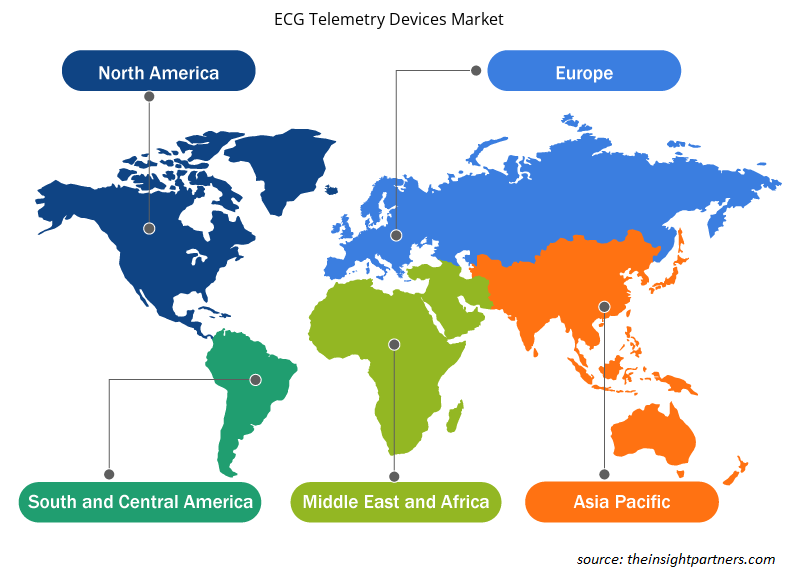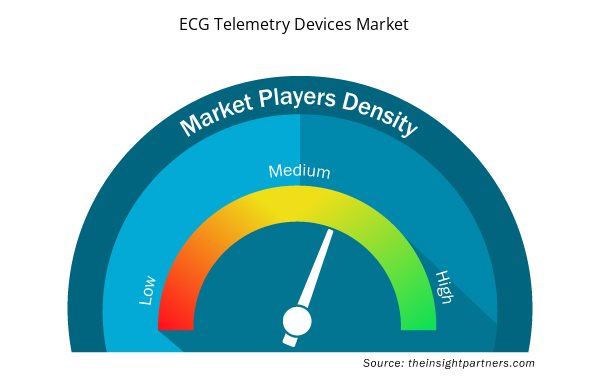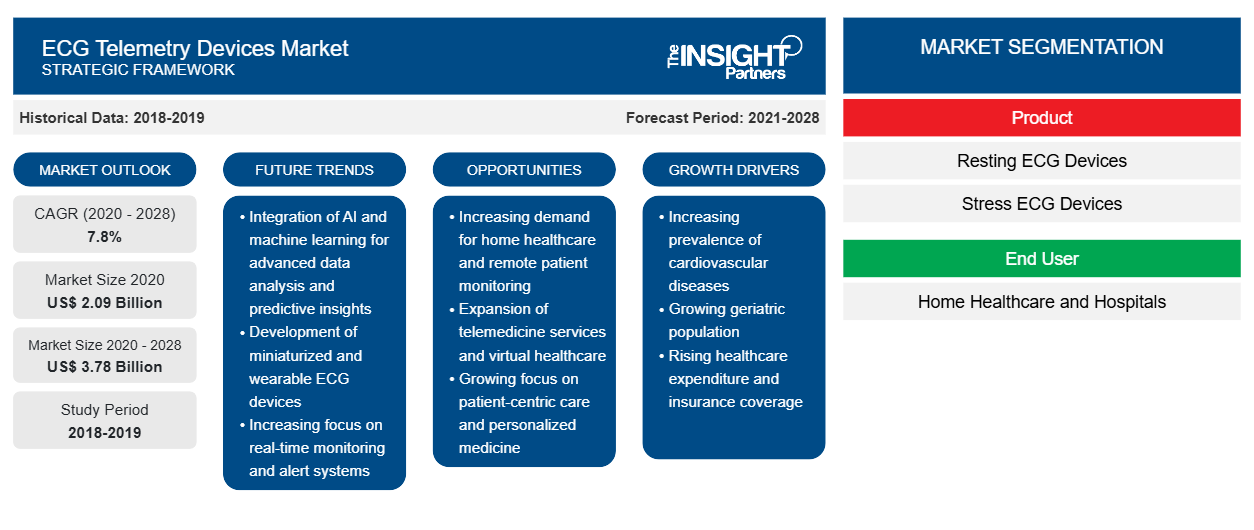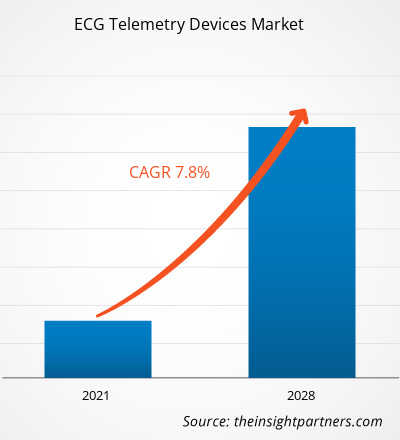Si prevede che il mercato dei dispositivi di telemetria ECG raggiungerà i 3.783,48 milioni di dollari entro il 2028, rispetto ai 2.087,66 milioni di dollari del 2020; si stima che crescerà a un CAGR del 7,8% nel periodo 2021-2028.
Il dispositivo ECG monitora e registra l'attività elettrica del cuore. L'ECG rileva gli impulsi elettrici generati dalla polarizzazione e dalla depolarizzazione del tessuto cardiaco e li traduce in una forma d'onda. Ciò aiuta il medico o il cardiologo a diagnosticare anomalie cardiache e a misurare le dimensioni e la posizione delle camere. La crescita del mercato dei dispositivi di telemetria ECG è attribuita a fattori quali l'aumento dell'incidenza delle malattie cardiovascolari e l'aumento della popolazione geriatrica. Tuttavia, l'elevato costo e gli svantaggi dei dispositivi di telemetria ECG frenano la crescita del mercato.
Personalizza questo report in base alle tue esigenze
Riceverai la personalizzazione gratuita di qualsiasi report, comprese parti di questo report, o analisi a livello nazionale, pacchetto dati Excel, oltre a usufruire di grandi offerte e sconti per start-up e università
- Scopri le principali tendenze di mercato in questo rapporto.Questo campione GRATUITO includerà analisi di dati che spaziano dalle tendenze di mercato alle stime e alle previsioni.
Approfondimenti di mercato
Aumento dell'incidenza delle malattie cardiovascolari
Il mondo ha assistito a notevoli sviluppi nella salute mobile (mHealth) nell'ultimo decennio, che sta offrendo a medici e pazienti nuovi approcci per gestire molte malattie, tra cui aritmie atriali, aritmie ventricolari, fibrillazione atriale ventricolare. La crescente prevalenza di aritmie e altre malattie cardiovascolari (CVD) sta innescando la necessità di metodi diagnostici migliorati. I sistemi di telemetria ECG sono gli strumenti più efficaci utilizzati per rilevare le aritmie. Questi dispositivi consentono un monitoraggio cardiaco più semplice e rapido, il che ha contribuito alla loro popolarità. Secondo l'Organizzazione mondiale della sanità (OMS), le CVD sono la principale causa di morte in tutto il mondo, con circa 30 milioni di persone che soffrono di un ictus ogni anno. Secondo l'American Heart Association, quasi la metà di tutti gli adulti negli Stati Uniti ha un tipo di CVD. Si stima che più di 130 milioni di persone, ovvero il 45,1% della popolazione statunitense, soffriranno di un tipo di CVD entro il 2035. Inoltre, la Società Europea di Cardiologia ha riferito che la fibrillazione atriale è l'aritmia più comune e rappresenta lo 0,28-2,6% della spesa sanitaria nei paesi europei. Ha anche menzionato che i pazienti affetti da fibrillazione atriale hanno un rischio cinque volte maggiore di avere un ictus e il 20-30% dei casi totali di ictus in Europa sono causati dalla fibrillazione atriale. Secondo lo studio condotto dalla Società Europea di Cardiologia nel 2016, nell'UE, circa 7,6 milioni di persone di età pari o superiore a 65 anni soffrivano di fibrillazione atriale. Secondo le stime della Società Europea di Cardiologia, si prevede che il numero aumenterà dell'89% per raggiungere circa 14,4 milioni entro il 2060. Si stima che la prevalenza della fibrillazione atriale raggiungerà il 9,5% entro il 2060 dal 7,8% del 2016. Inoltre, secondo il rapporto "Beyond the Burden: The Impact of Atrial Fibrillation in Asia Pacific" di Biosense Webster, pubblicato nel 2019, più di 16 milioni di persone nell'Asia Pacifica soffrono di fibrillazione atriale e si prevede che il numero raggiungerà circa 72 milioni entro il 2050. Il rapporto suggerisce anche che la condizione ha colpito maggiormente la popolazione di mezza età e anziana.
Alcuni dei principali fattori di rischio per le malattie cardiovascolari sono la storia familiare, l'etnia e l'età; altri fattori di rischio includono il consumo di tabacco, l'ipertensione, l'obesità, il colesterolo alto, l'inattività fisica, il diabete, le diete non sane e il consumo di alcol. Inoltre, i cambiamenti nello stile di vita stanno portando all'aumento dell'incidenza di malattie come diabete, ipertensione, dislipidemia e obesità, contribuendo a un aumento dei casi di malattie cardiovascolari in tutto il mondo. La maggior parte dei tipi di malattie cardiovascolari può essere prevenuta tramite il pre-monitoraggio e la pre-diagnosi. Allo stesso modo, le anomalie nel funzionamento del cuore, le aritmie, possono essere evitate con una diagnosi precoce. Per questo motivo, la domanda di dispositivi di telemetria ECG è in aumento poiché questi dispositivi aiutano a salvare i pazienti ad alto rischio di arresto cardiaco.
Approfondimenti basati sui prodotti
Il mercato dei dispositivi di telemetria ECG, per prodotto, è segmentato in dispositivi ECG a riposo, dispositivi ECG da sforzo e altri. Il segmento dei dispositivi ECG a riposo ha detenuto la quota maggiore del mercato nel 2020. Inoltre, si prevede che lo stesso segmento registrerà il CAGR più elevato nel mercato durante il periodo di previsione.
Informazioni basate sull'utente finale
In base all'utente finale, il mercato dei dispositivi di telemetria ECG è diviso in assistenza sanitaria domiciliare e ospedali. Il segmento ospedaliero ha detenuto una quota maggiore del mercato nel 2020 e si prevede che lo stesso segmento registrerà un CAGR più elevato nel mercato durante il periodo di previsione.
I lanci e le approvazioni di prodotti sono le strategie comunemente adottate dalle aziende per espandere la propria presenza globale e i portafogli di prodotti. Inoltre, gli operatori del mercato dei dispositivi di telemetria ECG si concentrano sulla strategia di collaborazione per ampliare la propria clientela, il che, a sua volta, consente loro di mantenere il proprio marchio a livello globale.
Approfondimenti regionali sul mercato dei dispositivi di telemetria ECG
Le tendenze regionali e i fattori che influenzano il mercato dei dispositivi di telemetria ECG durante il periodo di previsione sono stati ampiamente spiegati dagli analisti di Insight Partners. Questa sezione discute anche i segmenti di mercato dei dispositivi di telemetria ECG e la geografia in Nord America, Europa, Asia Pacifico, Medio Oriente e Africa e Sud e Centro America.

- Ottieni i dati specifici regionali per il mercato dei dispositivi di telemetria ECG
Ambito del rapporto di mercato sui dispositivi di telemetria ECG
| Attributo del report | Dettagli |
|---|---|
| Dimensioni del mercato nel 2020 | 2,09 miliardi di dollari USA |
| Dimensioni del mercato entro il 2028 | 3,78 miliardi di dollari USA |
| CAGR globale (2020 - 2028) | 7,8% |
| Dati storici | 2018-2019 |
| Periodo di previsione | 2021-2028 |
| Segmenti coperti | Per Prodotto
|
| Regioni e Paesi coperti | America del Nord
|
| Leader di mercato e profili aziendali chiave |
|
Densità degli attori del mercato: comprendere il suo impatto sulle dinamiche aziendali
Il mercato dei dispositivi di telemetria ECG sta crescendo rapidamente, spinto dalla crescente domanda degli utenti finali dovuta a fattori quali l'evoluzione delle preferenze dei consumatori, i progressi tecnologici e una maggiore consapevolezza dei vantaggi del prodotto. Con l'aumento della domanda, le aziende stanno ampliando le loro offerte, innovando per soddisfare le esigenze dei consumatori e capitalizzando sulle tendenze emergenti, il che alimenta ulteriormente la crescita del mercato.
La densità degli operatori di mercato si riferisce alla distribuzione di aziende o società che operano in un particolare mercato o settore. Indica quanti concorrenti (operatori di mercato) sono presenti in un dato spazio di mercato in relazione alle sue dimensioni o al valore di mercato totale.
Le principali aziende che operano nel mercato dei dispositivi di telemetria ECG sono:
- Società di scienza cardiaca
- Società anonima
- GE Healthcare Inc.
- Medtronic Inc.
- Azienda specializzata nella produzione di dispositivi medici Mindray Medical International Ltd.
Disclaimer : le aziende elencate sopra non sono classificate secondo un ordine particolare.

- Ottieni una panoramica dei principali attori del mercato dei dispositivi di telemetria ECG
Sottoprodotto
- Dispositivi ECG a riposo
- Dispositivi ECG da sforzo
- Altri
Per utente finale
- Assistenza sanitaria domiciliare
- Ospedali
Per Geografia
America del Nord
- NOI
- Canada
- Messico
Europa
- Francia
- Germania
- Italia
- Regno Unito
- Spagna
- Resto d'Europa
Asia Pacifico (APAC)
- Cina
- India
- Corea del Sud
- Giappone
- Australia
- Resto dell'Asia Pacifica
Medio Oriente e Africa (MEA)
- Sudafrica
- Arabia Saudita
- Emirati Arabi Uniti
- Resto del Medio Oriente e Africa
America del Sud e Centro (SCAM)
- Brasile
- Argentina
- Resto del Sud e Centro America
Profili aziendali
- Società di scienza cardiaca
- Società anonima
- GE Healthcare Inc.
- Medtronic Inc.
- Azienda specializzata nella produzione di dispositivi medici Mindray Medical International Ltd.
- Società Nihon Kohden
- Assistenza sanitaria Philips
- Società di assistenza ScottCare
- Trascinatore
- Società a responsabilità limitata Welch Allyn Inc.
- Analisi storica (2 anni), anno base, previsione (7 anni) con CAGR
- Analisi PEST e SWOT
- Valore/volume delle dimensioni del mercato - Globale, regionale, nazionale
- Industria e panorama competitivo
- Set di dati Excel



Report Coverage
Revenue forecast, Company Analysis, Industry landscape, Growth factors, and Trends

Segment Covered
This text is related
to segments covered.

Regional Scope
North America, Europe, Asia Pacific, Middle East & Africa, South & Central America

Country Scope
This text is related
to country scope.
Domande frequenti
The ECG Telemetry Devices market majorly consists of the players such as Cardiac Science Corporation, CompuMed Inc., GE Healthcare Inc., Medtronic Inc., Mindray Medical International Ltd., Nihon Kohden Corporation, Philips Healthcare, ScottCare Corporation, Dragger, Welch Allyn Inc. amongst others among others.
The global ECG Telemetry Devices market growth is mainly attributed to factors such the The market drivers include the increase in cardiovascular disease incidence and surge in geriatric population. However, high cost and disadvantages of ECG telemetry devices are key factors restraining the market growth.
Telemetry is an observation tool that allows continuous ECG, RR, SpO2 monitoring while the patient remains active without the restriction of being attached to a bedside cardiac monitor. Telemetry accuracy relies on skin preparation, electrode and lead placement, equipment maintenance, patient monitoring and education. ECG device monitors and record electrical activity of the heart and the device detects and picks up electrical impulses generated by the polarization and depolarization of cardiac tissue and translate them into waveform. This helps physician or cardiologist to diagnose cardiac abnormalities as well as size and position of chambers.
Trends and growth analysis reports related to Life Sciences : READ MORE..
The List of Companies - ECG Telemetry Devices Market
- Cardiac Science Corporation
- CompuMed Inc.
- GE Healthcare Inc.
- Medtronic Inc.
- Mindray Medical International Ltd.
- Nihon Kohden Corporation
- Philips Healthcare
- ScottCare Corporation
- Dragger
- Welch Allyn Inc.
The Insight Partners performs research in 4 major stages: Data Collection & Secondary Research, Primary Research, Data Analysis and Data Triangulation & Final Review.
- Data Collection and Secondary Research:
As a market research and consulting firm operating from a decade, we have published and advised several client across the globe. First step for any study will start with an assessment of currently available data and insights from existing reports. Further, historical and current market information is collected from Investor Presentations, Annual Reports, SEC Filings, etc., and other information related to company’s performance and market positioning are gathered from Paid Databases (Factiva, Hoovers, and Reuters) and various other publications available in public domain.
Several associations trade associates, technical forums, institutes, societies and organization are accessed to gain technical as well as market related insights through their publications such as research papers, blogs and press releases related to the studies are referred to get cues about the market. Further, white papers, journals, magazines, and other news articles published in last 3 years are scrutinized and analyzed to understand the current market trends.
- Primary Research:
The primarily interview analysis comprise of data obtained from industry participants interview and answers to survey questions gathered by in-house primary team.
For primary research, interviews are conducted with industry experts/CEOs/Marketing Managers/VPs/Subject Matter Experts from both demand and supply side to get a 360-degree view of the market. The primary team conducts several interviews based on the complexity of the markets to understand the various market trends and dynamics which makes research more credible and precise.
A typical research interview fulfils the following functions:
- Provides first-hand information on the market size, market trends, growth trends, competitive landscape, and outlook
- Validates and strengthens in-house secondary research findings
- Develops the analysis team’s expertise and market understanding
Primary research involves email interactions and telephone interviews for each market, category, segment, and sub-segment across geographies. The participants who typically take part in such a process include, but are not limited to:
- Industry participants: VPs, business development managers, market intelligence managers and national sales managers
- Outside experts: Valuation experts, research analysts and key opinion leaders specializing in the electronics and semiconductor industry.
Below is the breakup of our primary respondents by company, designation, and region:

Once we receive the confirmation from primary research sources or primary respondents, we finalize the base year market estimation and forecast the data as per the macroeconomic and microeconomic factors assessed during data collection.
- Data Analysis:
Once data is validated through both secondary as well as primary respondents, we finalize the market estimations by hypothesis formulation and factor analysis at regional and country level.
- Macro-Economic Factor Analysis:
We analyse macroeconomic indicators such the gross domestic product (GDP), increase in the demand for goods and services across industries, technological advancement, regional economic growth, governmental policies, the influence of COVID-19, PEST analysis, and other aspects. This analysis aids in setting benchmarks for various nations/regions and approximating market splits. Additionally, the general trend of the aforementioned components aid in determining the market's development possibilities.
- Country Level Data:
Various factors that are especially aligned to the country are taken into account to determine the market size for a certain area and country, including the presence of vendors, such as headquarters and offices, the country's GDP, demand patterns, and industry growth. To comprehend the market dynamics for the nation, a number of growth variables, inhibitors, application areas, and current market trends are researched. The aforementioned elements aid in determining the country's overall market's growth potential.
- Company Profile:
The “Table of Contents” is formulated by listing and analyzing more than 25 - 30 companies operating in the market ecosystem across geographies. However, we profile only 10 companies as a standard practice in our syndicate reports. These 10 companies comprise leading, emerging, and regional players. Nonetheless, our analysis is not restricted to the 10 listed companies, we also analyze other companies present in the market to develop a holistic view and understand the prevailing trends. The “Company Profiles” section in the report covers key facts, business description, products & services, financial information, SWOT analysis, and key developments. The financial information presented is extracted from the annual reports and official documents of the publicly listed companies. Upon collecting the information for the sections of respective companies, we verify them via various primary sources and then compile the data in respective company profiles. The company level information helps us in deriving the base number as well as in forecasting the market size.
- Developing Base Number:
Aggregation of sales statistics (2020-2022) and macro-economic factor, and other secondary and primary research insights are utilized to arrive at base number and related market shares for 2022. The data gaps are identified in this step and relevant market data is analyzed, collected from paid primary interviews or databases. On finalizing the base year market size, forecasts are developed on the basis of macro-economic, industry and market growth factors and company level analysis.
- Data Triangulation and Final Review:
The market findings and base year market size calculations are validated from supply as well as demand side. Demand side validations are based on macro-economic factor analysis and benchmarks for respective regions and countries. In case of supply side validations, revenues of major companies are estimated (in case not available) based on industry benchmark, approximate number of employees, product portfolio, and primary interviews revenues are gathered. Further revenue from target product/service segment is assessed to avoid overshooting of market statistics. In case of heavy deviations between supply and demand side values, all thes steps are repeated to achieve synchronization.
We follow an iterative model, wherein we share our research findings with Subject Matter Experts (SME’s) and Key Opinion Leaders (KOLs) until consensus view of the market is not formulated – this model negates any drastic deviation in the opinions of experts. Only validated and universally acceptable research findings are quoted in our reports.
We have important check points that we use to validate our research findings – which we call – data triangulation, where we validate the information, we generate from secondary sources with primary interviews and then we re-validate with our internal data bases and Subject matter experts. This comprehensive model enables us to deliver high quality, reliable data in shortest possible time.


 Ottieni un campione gratuito per questo repot
Ottieni un campione gratuito per questo repot